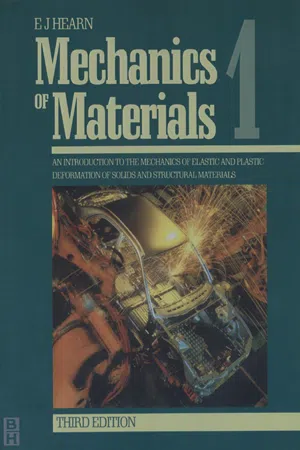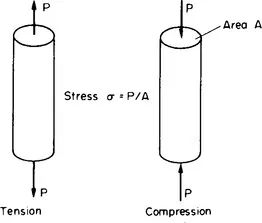
eBook - ePub
Mechanics of Materials Volume 1
An Introduction to the Mechanics of Elastic and Plastic Deformation of Solids and Structural Materials
- 450 pages
- English
- ePUB (mobile friendly)
- Available on iOS & Android
eBook - ePub
Mechanics of Materials Volume 1
An Introduction to the Mechanics of Elastic and Plastic Deformation of Solids and Structural Materials
About this book
One of the most important subjects for any student of engineering to master is the behaviour of materials and structures under load. The way in which they react to applied forces, the deflections resulting and the stresses and strains set up in the bodies concerned are all vital considerations when designing a mechanical component such that it will not fail under predicted load during its service lifetime.All the essential elements of a treatment of these topics are contained within this course of study, starting with an introduction to the concepts of stress and strain, shear force and bending moments and moving on to the examination of bending, shear and torsion in elements such as beams, cylinders, shells and springs. A simple treatment of complex stress and complex strain leads to a study of the theories of elastic failure and an introduction to the experimental methods of stress and strain analysis.More advanced topics are dealt with in a companion volume - Mechanics of Materials 2. Each chapter contains a summary of the essential formulae which are developed in the chapter, and a large number of worked examples which progress in level of difficulty as the principles are enlarged upon. In addition, each chapter concludes with an extensive selection of problems for solution by the student, mostly examination questions from professional and academic bodies, which are graded according to difficulty and furnished with answers at the end.* Emphasis on practical learning and applications, rather than theory* Provides the essential formulae for each individual chapter* Contains numerous worked examples and problems
Frequently asked questions
Yes, you can cancel anytime from the Subscription tab in your account settings on the Perlego website. Your subscription will stay active until the end of your current billing period. Learn how to cancel your subscription.
At the moment all of our mobile-responsive ePub books are available to download via the app. Most of our PDFs are also available to download and we're working on making the final remaining ones downloadable now. Learn more here.
Perlego offers two plans: Essential and Complete
- Essential is ideal for learners and professionals who enjoy exploring a wide range of subjects. Access the Essential Library with 800,000+ trusted titles and best-sellers across business, personal growth, and the humanities. Includes unlimited reading time and Standard Read Aloud voice.
- Complete: Perfect for advanced learners and researchers needing full, unrestricted access. Unlock 1.4M+ books across hundreds of subjects, including academic and specialized titles. The Complete Plan also includes advanced features like Premium Read Aloud and Research Assistant.
We are an online textbook subscription service, where you can get access to an entire online library for less than the price of a single book per month. With over 1 million books across 1000+ topics, we’ve got you covered! Learn more here.
Look out for the read-aloud symbol on your next book to see if you can listen to it. The read-aloud tool reads text aloud for you, highlighting the text as it is being read. You can pause it, speed it up and slow it down. Learn more here.
Yes! You can use the Perlego app on both iOS or Android devices to read anytime, anywhere — even offline. Perfect for commutes or when you’re on the go.
Please note we cannot support devices running on iOS 13 and Android 7 or earlier. Learn more about using the app.
Please note we cannot support devices running on iOS 13 and Android 7 or earlier. Learn more about using the app.
Yes, you can access Mechanics of Materials Volume 1 by E.J. Hearn in PDF and/or ePUB format, as well as other popular books in Technology & Engineering & Materials Science. We have over one million books available in our catalogue for you to explore.
Information
CHAPTER 1
SIMPLE STRESS AND STRAIN
1.1 Load
In any engineering structure or mechanism the individual components will be subjected to external forces arising from the service conditions or environment in which the component works. If the component or member is in equilibrium, the resultant of the external forces will be zero but, nevertheless, they together place a load on the member which tends to deform that member and which must be reacted by internal forces which are set up within the material.
If a cylindrical bar is subjected to a direct pull or push along its axis as shown in Fig. 1.1, then it is said to be subjected to tension or compression. Typical examples of tension are the forces present in towing ropes or lifting hoists, whilst compression occurs in the legs of your chair as you sit on it or in the support pillars of buildings.

Fig. 1.1 Types of direct stress.
In the SI system of units load is measured in newtons, although a single newton, in engineering terms, is a very small load. In most engineering applications, therefore, loads appear in SI multiples, i.e. kilonewtons (kN) or meganewtons (MN).
There are a number of different ways in which load can be applied to a member. Typical loading types are:
(a) Static or dead loads, i.e. non-fluctuating loads, generally caused by gravity effects.
(b) Live loads, as produced by, for example, lorries crossing a bridge.
(c) Impact or shock loads caused by sudden blows.
(d) Fatigue, fluctuating or alternating loads, the magnitude and sign of the load changing with time.
1.2 Direct or normal stress (σ)
It has been noted above that external force applied to a body in equilibrium is reacted by internal forces set up within the material. If, therefore, a bar is subjected to a uniform tension or compression, i.e. a direct force, which is uniformly or equally applied across the cross-section, then the internal forces set up are also distributed uniformly and the bar is said to be subjected to a uniform direct or normal stress, the stress being defined as

Stress σ may thus be compressive or tensile depending on the nature of the load and will be measured in units of newtons per square metre (N/m2) or multiples of this.
In some cases the loading situation is such that the stress will vary across any given section, and in such cases the stress at any point is given by the limiting value of δP/δA as δA tends to zero.
1.3 Direct strain (ε)
If a bar is subjected to a direct load, and hence a stress, the bar will change in length. If the bar has an original length L and changes in length by an amount δL, the strain produced is defined as follows:

Strain is thus a measure of the deformation of the material and is non-dimensional, i.e. it has no units; it is simply a ratio of two quantities with the same unit (Fig. 1.2).

Fig. 1.2
Since, in practice, the extensions of materials under load are very small, it is often convenient to measure the strains in the form of strain × 10−6, i.e. microstrain, when the symbol used becomes με.
Alternatively, strain can be expressed as a percentage straini.e

1.4 Sign convention for direct stress and strain
Tensile stresses and strains are considered POSITIVE in sense producing an increase in length. Compressive stresses and strains are considered NEGATIVE in sense producing a decrease in length.
1.5 Elastic materials – Hooke’s law
A material is said to be elasticif it returns to its original, unloaded dimensions whe...
Table of contents
- Cover image
- Title page
- Table of Contents
- Also of interest
- Copyright
- INTRODUCTION
- NOTATION
- Chapter 1: SIMPLE STRESS AND STRAIN
- Chapter 2: COMPOUND BARS
- Chapter 3: SHEARING FORCE AND BENDING MOMENT DIAGRAMS
- Chapter 4: BENDING
- Chapter 5: SLOPE AND DEFLECTION OF BEAMS
- Chapter 6: BUILT-IN BEAMS
- Chapter 7: SHEAR STRESS DISTRIBUTION
- Chapter 8: TORSION
- Chapter 9: THIN CYLINDERS AND SHELLS
- Chapter 10: THICK CYLINDERS
- Chapter 11: STRAIN ENERGY
- Chapter 12: SPRINGS
- Chapter 13: COMPLEX STRESSES
- Chapter 14: COMPLEX STRAIN AND THE ELASTIC CONSTANTS
- Chapter 15: THEORIES OF ELASTIC FAILURE
- Chapter 16: EXPERIMENTAL STRESS ANALYSIS
- APPENDIX 1: TYPICAL MECHANICAL AND PHYSICAL PROPERTIES FOR ENGINEERING METALS
- APPENDIX 2: TYPICAL MECHANICAL PROPERTIES OF NON-METALS
- APPENDIX 3: OTHER PROPERTIES OF NON-METALS
- INDEX
- Other Titles in the Series